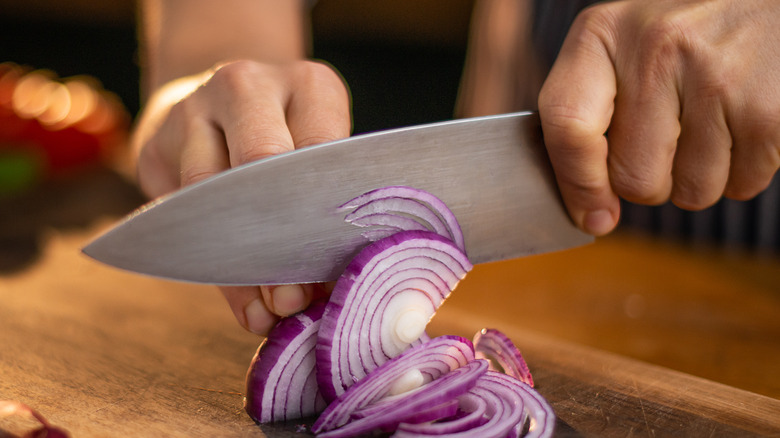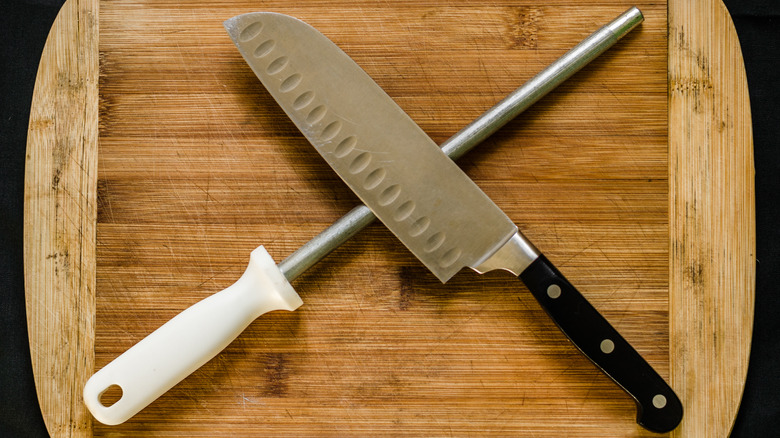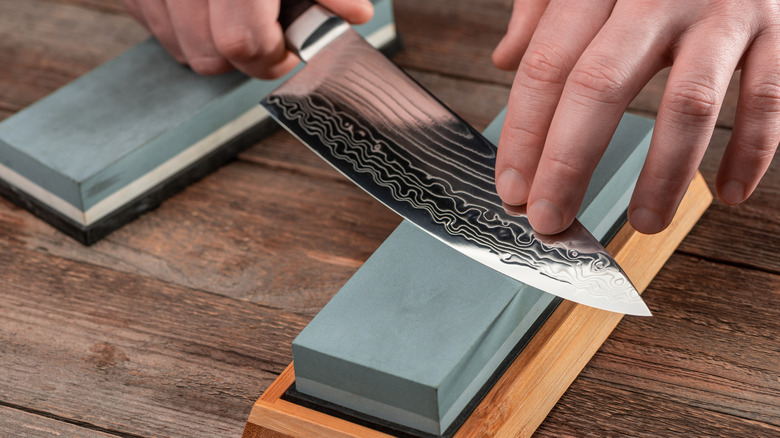What's The Difference Between Sharpening And Honing A Knife, And Why Does It Matter?
In the culinary world, there's a word for everything. Cooking vernacular in the restaurant industry is utterly unfamiliar to the uninitiated. Did you know dying on the pass means that a plate of food has spent too long sitting around unserved, or that if you return an undercooked dish to a restaurant kitchen, the chef will flash it, per Toast?
The language of food isn't exclusively used in restaurants. Fancy phraseology is abundant in the home kitchen as well. Even basic knife cuts have convoluted names. For example, if you slice a vegetable into long, thin strips, you might have used either the batonnet or julienne technique, depending on the width of the cut in question. Dicing your produce into tiny pieces is called brunoise, and compacting your herbs before chopping is the technique known as chiffonade. When referencing proper knife care, two terms are essential – sharpening and honing. The two terms may seem similar, but understanding the difference between them is essential.
Honing your knives helps keep them sharp
According to Made In Cookware, the practice of smoothing out the imperfections that form in the metal of your knife in the course of cutting and chopping up ingredients for dinner is called honing. Essentially, though you may not be able to see the small nicks in the blade, they will inevitably cause problems the next time you're slicing and dicing. Fortunately, honing can return your knife to its original, blemish-free form, and Made In Cookware explains that it does so without stripping any steel from the blade.
Consumer Reports tells us that the best way to realign a knife's edge is with a honing rod. By regularly taking an angled blade and scraping along the ridged steel tool, you might be able to keep your knife sharp for a longer period of time. Consumer Reports suggests honing your knives nearly every time you use them. However, honing won't do the trick once your knife has gone dull — that's where sharpening comes in.
Knives should be sharpened sparingly
The website MasterClass suggests that a knife should only be sharpened once or twice a year. Sharpening strips your knife of metal. As such, honing, which smooths the blade without wearing it down, is the much more sustainable facet of knife care. You can tell that sharpening is necessary when honing your knife doesn't give its blade a fine enough edge, per Made In Cookware. If a knife can't slice through a tomato cleanly, it isn't sharp enough – Jacques Pépin stands by a similar tomato trick.
Knife manufacturer Misen tells us Jacques Pépin thinks that a dull knife is a toothless tool. Instead of the tomato trick, Misen posits that a sufficiently sharp blade can cut cleanly through an onion without making the chef cry.
Fortunately, according to Cook's Illustrated, there are a number of ways to sharpen a knife. The most basic method utilizes the whetstone, a rough brick upon which the blade is brushed until the knife's edge is once again razor sharp. However, it is considerably easier to use either a manual or an electric knife sharpener. If you're in a pinch, you can even sharpen a kitchen knife on the unglazed base of a ceramic coffee mug.


